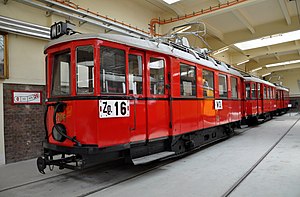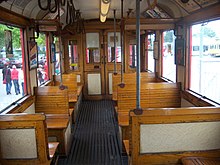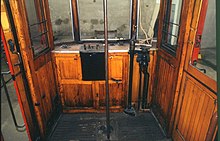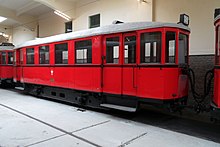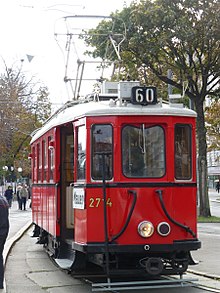Types N, n and n1 of the municipality of Vienna - urban trams
| N, n and n 1 | |
|---|---|
|
Two N railcars with an N sidecar coupled between them in the Remise Transport Museum
|
|
| Number: | 180 N, 150 n and 120 n 1 |
| Manufacturer: |
Simmeringer Waggonfabrik , Grazer Waggonfabrik , Enzesfeld Waggonfabrik , Lohner-Werke |
| Year of construction (s): | 1924-1927 |
| Gauge : | 1,435 ( standard gauge ) |
| Length over coupling: | 11,600 |
| Height: | 3,230 mm |
| Width: | 2,240 mm |
| Fixed wheelbase: | 3,600 mm |
| Top speed: | 40 km / h |
| Power system : | 750 or 600 V = |
| Power transmission: | Overhead line , pantograph |
| Number of traction motors: | 2 |
| Control: | Contactor control |
| Operating mode: | Bidirectional vehicle |
| Coupling type: | Trumpet clutch |
| Seats: | 24 |
| Floor height: | 945 mm |
The types N, n and n 1 the City of Vienna - urban trams were a series of 450 two-axle instinctual and sidecar , which for 1925 opened Wiener Electric light rail were designed and procured and the car of the steam rail , including related engines peeled off. In addition, they switched to the Vienna tram network on the 18G loop- through line, and from 1926 they were also used on pure tram lines.
Type N railcars
Car construction part
The appearance model for the type N railcars produced between 1925 and 1927 for the municipality of Vienna - urban trams (WStB) were the Cmg railcars of the local railway Vienna – Pressburg , which were designed in 1910 by Otto Wagner , who in turn was the architect of the Vienna steam light rail . Compared to the fleet of cars previously used by the Viennese tram, which mainly consisted of delicate and mostly very small vehicles, the electric light rail trains were extremely bulky.
The N railcars weighed 17,500 kilograms and had a wooden car body on a plate frame bogie that was reinforced with angle iron . Leaf springs and sliding axle bearings , the latter also cushioned by leaf springs , ensured smooth running . As a roof served barrel roof , which, depending had a forehead ventilation via the two internal cross walls, which separated the passenger compartment of the platforms. The dimensions of the vehicles were the same as those of the types M, m 2 and m 3 trams that had already been planned but had not yet been ordered for financial reasons, and their mechanical construction differed only in the shape of the bogie. The light rail operation required a different chassis than the one that the new trams were to get.
The car body - which was strongly drawn in in the area of the platforms - was 2,240 millimeters wide and 10,700 millimeters long, the length over the coupling was 11,600 millimeters, the wheelbase was 3,600 millimeters and the height between the top edge of the rails and the top edge of the roof was 3,230 millimeters. The wheels themselves had a running circle diameter of 850 and 870 millimeters, respectively. The wheel tires were 100 millimeters wide, the flanges 22 millimeters high. Another characteristic feature were the wide window pillars, with - compared to the previous series of Viennese trams - the number of windows was halved from eight to four. This construction corresponded to the standard of the time, the wide window pillars gave the car body sufficient strength. The windows themselves were 1,000 millimeters wide, and a relief device ensured that they were easy to open and close.
The two fully glazed platforms were comparatively long with a length of 2,300 millimeters, while the passenger compartment, separated by wide double doors, was 6,100 millimeters long. This contained 24 wooden seats, half of which were arranged lengthways or crossways to the direction of travel. The 47 to 60 standing places, depending on the occupancy, were distributed as follows:
| on the front platform, if it was manned: | twelve as a rule | 15 in case of overcrowding |
| on the rear platform, in the case of non-leading railcars also on the front platform: | 15 as a rule | 20 in case of overcrowding |
| in the passenger compartment: | 20 as a rule | 25 in case of overcrowding |
The two entrances on each side were closed by 1,200 millimeter wide, manually operated telescopic sliding doors. However, these were stiff and therefore not very useful for rapid transit operations . Operation by pressing the door lock with the thumb and pulling it with the hand at the same time was almost impossible, especially for weaker people. The doors were therefore only rarely closed while driving. An exception was the sliding door of the driver's platform, which had to be operated by the train attendant. Right from the start, there were serious, mostly fatal accidents involving jumping up or down. For the transition to tram routes, the cars also had collecting baskets with tactile grids and a bell belt .
brake
The service brake was an indirect, automatic, multi - release Kunze-Knorr compressed air brake that was operated by the driver with the right hand while the left hand operated the drive switch. The compressed air brake also worked when the train was separated , when the mechanical travel lock was driven over and when the vehicle was braked . For this purpose, two emergency brake handles were installed in each car. Spindle hand brakes were used as parking brakes , but they were only necessary for tram operation. The compressed air and hand brakes acted on all eight brake pads , and in the event of an emergency braking, the sand spreader, which is also operated with compressed air, was automatically activated .
An electrically driven compressor was installed on each railcar to generate the compressed air . The resulting compressed air was stored in two main tanks. The up to three railcars of a train were connected to each other by the compensation line. Safety valves responded to protect the system at seven bar. The brake equipment was supplied with the necessary compressed air of four and a half bar via a rapid pressure regulator. On each driver's cab there was a driver's brake valve with the six positions close, drive, release, downhill brake, service brake and emergency brake.
A special feature was the release of the mechanical travel lock when driving over a signal indicating a stop by means of a laterally protruding, rotatable release lever on the lower edge of the bogie of the railcar, between the axles. Only the left release lever of the leading railcar was active. Turning the lever backwards led to rapid braking by venting the main air line , and the power supply to the traction motors was also interrupted.
Electrical equipment
The cars each had two four-pole, ventilated DC main circuit motors with reversing poles . Four different types were used, but they were fully compatible with each other:
| GDTM 42 | AEG | 72 kW | 700 min -1 |
| GDTM 242 | AEG | 66.5 kW | 727 min −1 |
| US 701 | AEG | 70 kW | 715 min −1 |
| D 871 | Siemens-Schuckert | 70 kW | 667 min −1 |
The other electrical equipment for a top speed of 40 km / h consisted of two slip ring drive switches from ELIN , each with twelve travel but without braking levels, a contactor control , a pantograph, fresh electricity heating and interior lighting with two series of eight lamps each. The multiple control system, which was quite advanced for the time, enabled a maximum of three multiple units working at the same time to be operated in a train set, making a total of nine car trains possible. In addition to the spiral wire resistors on the car roof, a second set was arranged inside the car under the bench seats. By switching over, the latter were used for heating purposes in winter.
Because of the constantly changing lighting conditions at the transition between open routes and tunnel sections, a special device ensured that the interior lighting, consisting of six ceiling lamps, was automatically switched on and off. The different contact wire heights on open sections of the route and in the tunnels were used for this purpose. To do this, the pantograph - which lowered itself by itself when entering a low tunnel - pressed a special light switch on the roof of the car until the train reached daylight again.
statistics
The major order for a total of 180 Type N wagons was divided between three manufacturers as follows:
| Simmeringer Waggonfabrik : | 99 cars | Road numbers 2701-2799 | Year of construction 1925 |
| Grazer Waggonfabrik : | 11 cars | Road numbers 2800–2810 | Year of construction 1925 |
| Waggonfabrik Enzesfeld : | 40 cars | Road numbers 2811-2850 | Years of construction 1925 and 1926 |
| Simmeringer Waggonfabrik: | 30 cars | Road numbers 2851-2880 | Year of manufacture 1927 |
Type n sidecar
Apart from the lack of electrical equipment, the total of 150 type n trailer cars corresponded to the type N railcars and had a mass of 9,500 kilograms. The arrangement of the 24 seats also corresponded exactly to the railcars. Due to the lack of driver's cab facilities on the platforms and the lack of staff there, the sidecars offered 53 to 75 standing places. These were distributed as follows:
| on the front platform: | 16.5 as a rule | 25 in case of overcrowding |
| on the rear platform: | 16.5 as a rule | 25 in case of overcrowding |
| in the passenger compartment: | 20 as a rule | 25 in case of overcrowding |
The type n sidecars were manufactured as follows:
| Simmeringer Waggonfabrik: | 10 cars | Road numbers 5501–5510 | Year of manufacture 1924 |
| Simmeringer Waggonfabrik: | 70 cars | Road numbers 5511-5580 | Year of construction 1925 |
| Grazer Waggonfabrik: | 30 cars | Road numbers 5581–5610 | Year of construction 1925 |
| Waggonfabrik Enzesfeld: | 40 cars | Road numbers 5611–5650 | Year of construction 1925 |
Type n 1 sidecar
The sidecars of the slightly modified type n 1 largely corresponded to their predecessor series n. To save weight, however, they did not have their own bogie, but long girders made of deep-drawn sheet steel, which were reinforced with angle iron. They also had a wooden protective frame for use in trams. The car body was supported directly on the sliding axle bearings via four leaf springs. They were only sprung in one stage, the mass was reduced to 9,000 kilograms. In addition to the three already known manufacturers, the Lohner-Werke also participated in the construction of the 120 lighter light rail sidecars:
| Simmeringer Waggonfabrik: | 60 cars | Road numbers 5701–5760 | Year of manufacture 1926 |
| Grazer Waggonfabrik: | 19 cars | Road numbers 5761-5779 | Year of manufacture 1926 |
| Simmeringer Waggonfabrik: | 26 cars | Road numbers 5780-5805 | Year of manufacture 1927 |
| Lohner works: | 15 cars | Road numbers 5806–5820 | Year of manufacture 1927 |
Use in pure light rail traffic (1925–1961)
The vehicles of the first generation had their last day of use on April 3, 1961. In total, a nine-car train of the first generation could carry up to 856 people, 216 of them seated:
- 84 in the manned railcar
- 178 in the two unmanned railcars
- 594 in the six sidecars
Use on line 18G and in pure tram traffic (1925–1968)
The official testing of light rail vehicles in the tram network took place on October 14, 1925, i.e. more than four months after the electric light rail went into operation and only six days before the mixed operation line 18G went into operation, on the line 118 between Erdberg station and Währinger Gürtel station. After the structural verification of the bridges and vaults on this route, the authorities approved their use between Marsanogasse and Ghegaplatz. The crossing over the culvert of the Wiener Neustädter Canal , however, could not be approved due to its lower load-bearing capacity.
The light rail vehicles initially only entered the tram network on line 18G, which first ran on October 20, 1925. However, the n sidecars quickly proved to be unsuitable for tram operation due to their bogies. They were thus replaced on line 18G by the lighter n 1 sidecars delivered from March 1926 . The last day of use of a heavy n-sidecar in the tram network was April 19, 1926.
The first pure tram line to be operated by light rail vehicles was line 18 from October 4, 1926. With the start of the global economic crisis in October 1929, the number of light rail vehicles turned out to be too large. The decision to use tram-like vehicles on the tram, which was criticized at the time, turned out to be the right one, because from 1929 onwards, surplus tram sidecars and, from 1930 on, suburban rail cars on the tram network could replace small, outdated and uneconomical vehicles. After corresponding modifications and a new calculation, the above-mentioned culvert was finally released for use by light rail vehicles on September 12, 1932. In the meantime, however, the tram management decided to use the light rail vehicles on line 60 instead of the originally planned line 118.
For pure tram traffic, a total of 26 N railcars and 45 N 1 side cars have been stationed outside the light rail network over the years , but never all of them at the same time. The main use was the Speising depot . The following table provides an overview of the use of light rail vehicles on pure tram lines:
| 16 | from April 14, 1946 to early September 1947, only sidecars |
| 17th | from March 30, 1932, sidecar only |
| 18th | from October 4, 1926 to July 10, 1932, three-car trains |
| 57 | from June 15, 1943 to February 21, 1945, ten railcars and ten sidecars were stationed in the Wienzeile depot |
| 60 | from November 22, 1929 only sidecars, from October 20, 1932 to June 14, 1968 also complete three-car trains |
| 60/62 | from November 24, 1963, i.e. from the introduction of this line |
| 62 | from January 5, 1930, sidecar only |
| 117 | from March 30, 1932, sidecar only |
| 132 | from 1954, only sidecar |
| 231 | from 1954, only sidecar |
The last day of operation of an N / n 1 light rail train in the tram network was June 14, 1968, i.e. more than seven years after these types were last used in the light rail network.
Modifications of the cars used in the tram network
From 1932, the light rail vehicles used exclusively in the tram network were given classic tram wheel sets due to their better wear behavior when operating in the street. However, this meant that they could no longer be used universally. Regardless of this, they kept their red light rail paint. From May 1935, the first of these cars were finally given the so-called Zurich light coupling on the roof on a trial basis , so that the cable coupling for the multiple control was omitted.
Whereabouts
The majority of the cars were converted into 130 class N 1 railcars and 200 sidecars from the n 2 class between 1954 and 1962 . The remaining 50 railcars and 70 sidecars were either lost due to the war or were decommissioned, sold or converted into work cars in the 1960s .
Wiener Lokalbahnen acquired five railcars and three sidecars in 1963 . Six of them were used there after some modifications from 1965/1966 with numbers 241, 242 and 243 (railcars) or 281, 282 and 283 (sidecars), mostly as a three-car train in the order N + n + N, at football games in the Südstadt also as a five-car train in the order N + n + N + n + N. For use by the WLB, which lasted until 1971, the former light rail vehicles were given additional headlights and direction indicators - each only arranged on one platform. Also in 1963, the St. Pölten tram also bought a single railcar. This was the last light rail vehicle of the first generation ever, in use until January 17, 1973.
literature
- Alfred Horn: Wiener Stadtbahn. 90 years of light rail, 10 years of underground. Bohmann-Verlag, Vienna 1988, ISBN 3-7002-0678-X .
Web links
Individual evidence
- ↑ Harald Marincig: 60 Years of the Vienna Electric City Railways 1925–1985 , Wiener Stadtwerke - Verkehrsbetriebe, Vienna 1985, p. 8
- ^ A b c d e Alfred Laula, Alfred Rosenkranz: Viennese tram cars - technology and photos . Josef Otto Slezak, Vienna 1983, ISBN 3-85416-092-5 , p. 88
- ↑ Type sketch on a scale of 1: 100 in: Walter Krobot, Josef Otto Slezak, Hans Sternhart: Tram in Vienna - the day before yesterday and the day after tomorrow . 2nd, revised edition, Josef Otto Slezak, Vienna 1983. ISBN 3-85416-076-3 , p. 230.
- ↑ a b c d e f g h Chapter Stadtbahn in: Städtewerk: Das neue Wien , Elbemühl, Vienna, 1928, pp. 98–115
- ^ Alfred Horn: Wiener Stadtbahn. 90 years of light rail, 10 years of underground. Bohmann-Verlag, Vienna 1988, ISBN 3-7002-0678-X , p. 141.
- ↑ a b c d e f g h Alfred Horn: Wiener Stadtbahn. 90 years of light rail, 10 years of underground. Bohmann-Verlag, Vienna 1988, ISBN 3-7002-0678-X , p. 142.
- ^ A b Alfred Horn: Wiener Stadtbahn. 90 years of light rail, 10 years of underground. Bohmann-Verlag, Vienna 1988, ISBN 3-7002-0678-X , p. 143.
- ^ Alfred Horn: Wiener Stadtbahn. 90 years of light rail, 10 years of underground. Bohmann-Verlag, Vienna 1988, ISBN 3-7002-0678-X , p. 139.
- ^ Alfred Laula, Alfred Rosenkranz: Viennese streetcar - technology and photos . Josef Otto Slezak, Vienna 1983, ISBN 3-85416-092-5 , p. 66.
- ^ Hans Peter Pawlik, Josef Otto Slezak: Wagner's work for Vienna. Total work of art Stadtbahn (= International Archive for Locomotive History. Volume 44). Slezak, Vienna 1999, ISBN 3-85416-185-9 , p. 153
- ^ Alfred Laula, Alfred Rosenkranz: Viennese streetcar - technology and photos . Josef Otto Slezak, Vienna 1983, ISBN 3-85416-092-5 , p. 80.
- ^ Harald Helml: Stadtbahn and U-Bahn in Vienna. On the history of a delayed means of mass transport. Vienna 2011, pp. 79–80 ( available online on the website of the University Library of the University of Vienna ).
- ^ Alfred Horn: Wiener Stadtbahn. 90 years of light rail, 10 years of underground. Bohmann-Verlag, Vienna 1988, ISBN 3-7002-0678-X , p. 158.
- ^ Alfred Horn: Wiener Stadtbahn. 90 years of light rail, 10 years of underground. Bohmann-Verlag, Vienna 1988, ISBN 3-7002-0678-X , p. 159.
- ↑ Hans Peter Pawlik, Josef Otto Slezak : Wiener Straßenbahnpanorama - pictures from the time from 1865 to 1982 . 2nd, revised edition, Josef Otto Slezak, Vienna 1992, ISBN 3-85416-105-0 , p. 109.
- ↑ Wiener Stadtbahn - motor coaches and sidecars in WLB design. In: Eisenbahnverkehr aktuell, October 1992, p. 20
